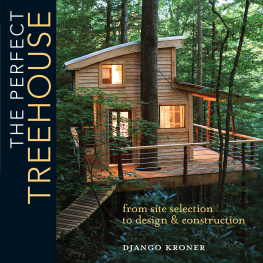



Contents
Introduction
Its Not the Destination, Its the Journey

Finca Bellavista is creating a sustainable treehouse community in Costa Rica.
Introduction
Its Not the Destination, Its the Journey
I am blown away by the variety and splendor of treehouses today. The creativity and craftsmanship that people bring to building in trees fills me with joy. Never in my wildest dreams could I have fathomed the depth and breadth of this worldwide movement. It is truly glorious.
Having traveled the world in pursuit of treehouses, I have the privilege of reporting on how things look on the front lines. The United States is leading the charge, with several treehouse-only building companies and countless contractors offering the service. Europe is in the midst of a treehouse renaissance. There, the Germans are leading the way with outfits like Baumbaron, led by Johannes Schelle and one of our earliest workshop participants, Christopher Richter. Andreas Wenning, also based in Germany, is breaking the rules with breathtaking modernist arboreal sculptures.

The Mirrorcube, in Sweden, defies gravity and expands the concept of what is possible.

A sprawling broadleaf maple supports a more humble creation on the Olympic Peninsula in Washington State.

The spirit of the treehouse reigns supreme in Andreas Wennings arboreal architecture.

In Japan, Takashi Kobayashi leads a national movement back into the forest with enticing designs like this.
Farther north, the Swedes are taking things to new levels with a hotel that tests the limits of imagination. Five individual treehouses, each more unusual than the next, accommodate guests at the Treehotel in a beguiling array: One is a birds nest, another a flying saucer. A third is a mirrored cube outfitted with an infrared shield invisible to the human eye but fully visible to birds that would otherwise be doomed to crash into it.
Ricardo Brunellis treehouse-building company, Casa na rvore in Brazil, is thrivingat least in the rarified air of the well-heeled. Finca Bellavista, a 600-acre treehouse community in Costa Rica, has sold out its second phase of building sites and its going strong. Takashi Kobayashi in Japan has more work than he knows what to do with. My friend Philip van Wassenaer, who runs a specialized tree-testing company in Toronto, is pull-testing trees all over the world for people interested in building treehouse hotels.
In terms of the treehouses safety record, so far so gooda concern as we move headlong into the fun of all of this. We must be mindful of doing things safely and correctly. Lets not hurt ourselves here. There still does not exist a meaningful treehouse association and informational clearinghouse, though we sure do talk about it a lot at the annual World Treehouse Association conferences. It is a challenge to convince building authorities that connecting to living trees is safe, but we can surely build to a standard on a level with the widely accepted International Building Code (IBC). A significant purpose of this book is to share best practices in construction methods as I know them. The last update in this regard was made in 1997 in my book Home Tree Home, right before the technological breakthrough of the treehouse attachment bolt (TAB).
A lot has changed since then.
The book deliberately concentrates on techniques for designing and building treehouse platforms, and not on the construction that takes place above the platforms. We have much ground to cover on how to connect respectfully and responsibly to living trees. Mastering this critical aspect of building in the trees opens the door to the conventional stick-frame construction that comes afterward. Build a strong and flexible platform and you can be assured that all the effort to create the structure above will not be in vain. What you put on that platform will be left to you, but I hope the rest of the book will provide some inspiration.
First, an update on the Nelson family journey and a warm-up visit to Treehouse Point, our treehouse-based bed-and-breakfast in Issaquah, Washington, and then we will get right into it.

A cairn, carefully balanced by a guest at Treehouse Point, stands peacefully on the bank of the Raging River.
The Nelson familys journey has continued on a less precarious but still elevated level. Since my last treehouse book, New Treehouses of the World, was published in 2009, our lives have revolved around the world of building in trees. As far as the treehouse-building business was going, the spring of 2009 was a particularly troubling time economically around here. It was the end of the golden years of home equity loans, when people were spending ravenously on luxury items. When the music stopped, so did our world of building treehouses for the wealthy, or at least the moderately qualified. We barely found our chairs. In fact, it took only four months for our future bookings to run dry. People felt poor, even fabulously rich ones. And Treehouse Point, our bed-and-breakfast, almost brought our family to the edge of financial catastrophe. Lets just say that when the bank considered lending me, a carpenter, the money to buy the Treehouse Point property with a low documentation loan, the broker returned to suggest we modify our application and ask for a no documentation loan. All I had to do was sign my name. Sweet! Treehouse Point also cast us in a bad light with the local building authorities.
Oddly, perhaps, the Nelson family has fond memories of those less hectic days. Over the summer of 2009, when we would normally have been pressed to our limits with projects, we found ourselves enjoying the company of family and friends at a bend in the Raging River. Unemployment Beach was our name for that stretch of the river, and the rocky turn provided a setting that helped us all reflect on the most important things in life. Everyone in a small circle of friends pooled resources and came together like never before. We even got to know our own family a little better.
During this happily conflicted time, we had the opportunity to plan and build at Treehouse Point, which at that time comprised only two treehouses. The propertys four acres of mature trees was practically a blank canvas that awaited our combined creativity, sweat, and toil. My mind raced with thoughts of treehouse designs and outbuildings to support them. My daughter Emily, now in her twenties, guarded the forest and reined in the overly ambitious or downright nonsensical. Charlie and Henry, our twin boys two years her junior, otherwise occupied space and were constant sources of pride and entertainment. My wife, Judy, endured the crucial and unglamorous side of paying the bills, checking in guests, and making sure the toilet paper didnt run out in the one communal bathroom.
Next page
















